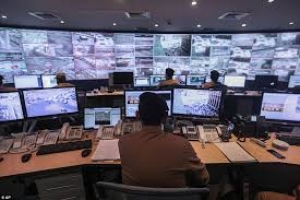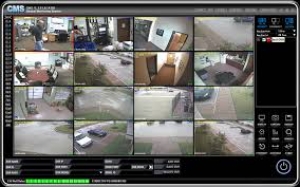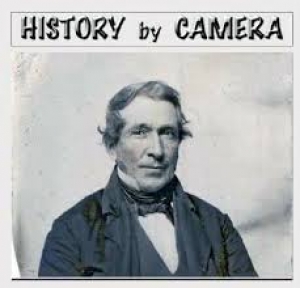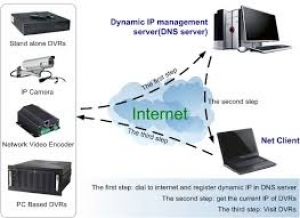CCTV Watches the World Go By
Article excerpt
CLOSED - CIRCUIT surveillance systems used with other methods of access control support security departments at land transportation facilities, airports, and seaports. They increase security officer efficiency and productivity, and the end result is a more secure facility
At first glance, securing land transportation facilities may seem to be an overwhelming task, but taken in sections, such facilities can be easily secured with the help of CCTV CAMERA
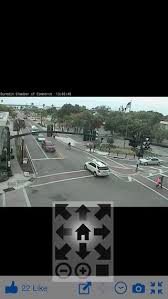
The inner perimeters of bus, train, and subway stations can be defined as the entrance gates to various platforms or terminals. In these areas, CCTV systems are used both as monitoring devices and as deterrents
CCTV cameras monitor passenger activities and allow security officers to watch for criminal action, disturbances, and passengers who may need assistance. CCTV cameras placed in obvious locations serve as deterrents and provide a sense of security to passengers
CCTV equipment is also used in storage areas, such as rail yards, to help secure access and deter theft
Another form of land transportation is the highway system. Highway access is controlled by toll booths, tunnels, and bridges. Perimeter access control is maintained by the governing authorities in these areas
Access control here involves more than keeping traffic out of an area or limiting access to it. Access control also means ensuring access to an area. It is vitally important to maintain efficient access to industrial, commercial, and financial centers
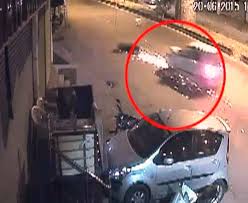
Montreal is an example of how important access control is to a major metropolitan area. CCTV cameras are strategically located on both the Champlain Bridge and the Jacques-Cartier Bridge, the main access arteries to the island of Montreal from the south shore
These cameras are part of a surveillance system that also includes CCTV monitors and VCRs and is controlled by a microprocessor-based control system. This system is used with traffic control signals to keep the traffic flowing during the morning and evening rush hours
CCTV systems are also used to monitor traffic on heavily traveled sections of highways. This surveillance allows traffic engineers to see problems on their monitors in their control location. From there they can adjust the computer-controlled traffic lights and alert emergency squads
Not only does this monitoring help traffic engineers but law enforcement officers also benefit. CCTV enables highway patrols to respond more effectively to emergencies, traffic snarls, and dangerous weather conditions
Law enforcement has recently started using CCTV cameras to monitor unstaffed toll booths. Cameras are monitored by police officers who then alert officers in the area of toll booth violations
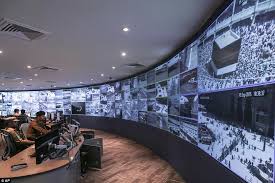
Tunnels provide another interesting application for CCTV systems. Here, because it is unsafe for security personnel to patrol, CCTV is used for traffic control. Cameras in tunnels keep a 24-hour watch over traffic flow, and VCRs permit personnel to quickly review incidents. Officers are able to see traffic jams, fires, and accidents and, therefore, can provide immediate assistance
A final example of a land transportation facility that uses CCTV systems is parking garages. CCTV systems are used in multilevel parking garages at entrances and exits to ensure safe vehicular passage and inside the garage to prevent vandalism, theft, and assaults
Land transportation facilities and roadways have widely variable lighting conditions. On highways and bridges, cameras are mounted high on structures in unprotected areas. In tunnels, parking garages, and bus, train, and subway stations cameras are lo-cated in confined, low-light level areas. But no matter the conditions, CCD cameras provide the answer
CCD cameras are perfect for these applications because of their high sensitivity, reliability, and versatility. These cameras produce high-quality images in a variety of lighting conditions. …
DVR Viewer Software Provides Remote Surveillance for Business
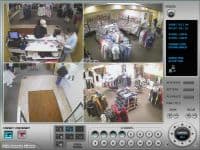 The world has changed a lot in the past few years, thanks in no small part to the digital revolution, including great advances in the Internet, networking, security camera systems, DVR viewer surveillance software, and personal computers. Possibly nothing has changed more than the business world, which has countless new tools at its disposal to not only help the company make money, but keep its merchandise, and employees safer. Through the advent of network enabled digital vedio recorder (DVRs), DVR viewer software, and high speed internet connections, it is now possible for a business to monitor their stores and warehouses remotely, from any part of the world, as long as they have a high speed internet connection.
The world has changed a lot in the past few years, thanks in no small part to the digital revolution, including great advances in the Internet, networking, security camera systems, DVR viewer surveillance software, and personal computers. Possibly nothing has changed more than the business world, which has countless new tools at its disposal to not only help the company make money, but keep its merchandise, and employees safer. Through the advent of network enabled digital vedio recorder (DVRs), DVR viewer software, and high speed internet connections, it is now possible for a business to monitor their stores and warehouses remotely, from any part of the world, as long as they have a high speed internet connection.
This makes many different things possible for a company when they are monitoring their business, and for this article, we will focus on employee safety. Employee safety is critical to the operation of a business because if the employees do not feel safe, they will not want to work for you. While our world does appear to be getting safer with record low crime statistics, armed robberies do still take place and it is up to you as the owner of a business to ensure that your employees are safe in the event of one.
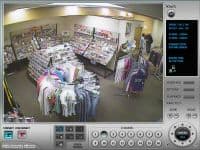 One of the best ways to do this is by installing a video surveillance system with remote viewer capability so that someone can monitor your business remotely over the Internet. This means that if you have employees working late into the night, in a bad neighborhood, you can be at home watching that they are safe. You can also hire a company to monitor your security camera for you. This is the equivalent of having a remote security guard.
One of the best ways to do this is by installing a video surveillance system with remote viewer capability so that someone can monitor your business remotely over the Internet. This means that if you have employees working late into the night, in a bad neighborhood, you can be at home watching that they are safe. You can also hire a company to monitor your security camera for you. This is the equivalent of having a remote security guard.
Let’s look at a scenario to show just how safe you make them. You are at home watching your business on the computer using DVR viewer software connected remotely to your surveillance system located at work. The DVR of the surveillance system is connected to the router at your business so that it can be accessed over the Internet. You log into the DVR viewer and are able to see your employees talking to customers and doing the usual evening business activities. Everything looks to be good and in order when you suddenly see some shady characters looking at the counter and casing out the business. Your employees are busy with other customers and they do not see the possible danger. Now, you have the choice of one of two things. You can call your business and alert your employees to keep an eye on the shady customers, or you can wait to see if something happens and if it does, call the police immediately.
The point is not which option you decide to take, as both will greatly improve the chances of a safe outcome for your employees. The point is that you have the options themselves, and without the shady customers even knowing it, your surveillance system has provided an eye in the sky that they have not anticipated.
There was a time, long ago, when having this sort of sophisticated set up required high priced security cameras and CCTV equipment that could be used to monitor your business remotely. This meant huge equipment and installation costs, and for most companies, it was simply not worth the price on the off chance of a robbery.
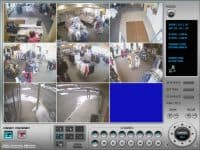 Things, however, have changed incredibly and that is no more apparent than in the current prices of surveillance systems. For as little as $1200, you can buy a professional CCTV surveillance system from CCTV Camera Pros, including 4 dome security cameras (the indoor dome cameras used in the system pictured throughout this article), a 4-channel surveillance DVR including DVR viewer software (the 4 channel version of the DVR used in the pictures on this page), and all of the cables and connecters needed for a simple plug and play installation. These systems will record video of what is happening in the store digitally onto the hard drive of the DVR. The DVR of this particular system comes with a 250 GB hard disk drive that is capable of storing about a week worth of video. Upgrades are available if more video storage is needed, and the surveillance video can be backed up using the built in CD burner or USB drive. This system is also networkable which means that you can access your cameras remotely over the Internet using the DVR viewer software that comes with the system. You probably already have an Internet connection and computer at work, so all that is left is buying a networkable video surveillance system.
Things, however, have changed incredibly and that is no more apparent than in the current prices of surveillance systems. For as little as $1200, you can buy a professional CCTV surveillance system from CCTV Camera Pros, including 4 dome security cameras (the indoor dome cameras used in the system pictured throughout this article), a 4-channel surveillance DVR including DVR viewer software (the 4 channel version of the DVR used in the pictures on this page), and all of the cables and connecters needed for a simple plug and play installation. These systems will record video of what is happening in the store digitally onto the hard drive of the DVR. The DVR of this particular system comes with a 250 GB hard disk drive that is capable of storing about a week worth of video. Upgrades are available if more video storage is needed, and the surveillance video can be backed up using the built in CD burner or USB drive. This system is also networkable which means that you can access your cameras remotely over the Internet using the DVR viewer software that comes with the system. You probably already have an Internet connection and computer at work, so all that is left is buying a networkable video surveillance system.
While crooks and robbers will not know you have a remote viewable video surveillance system set up that can be monitored from anywhere, your employees will. For them, they will see the measure of setting up the security cameras as an indication of how you care for your employees and your desire to keep them safe. They will feel more at ease at their job when the ‘eye in the sky’ is watching to alert them of any danger, while at the same time, giving them the ease of mind that comes from knowing that if someone does rob the store, they won’t have to wait to call the police until after they leave and that video will be captured to help prosecute.
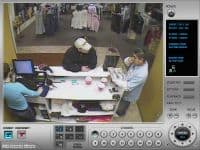 Setting up a surveillance system in your businesses means that it is much harder to get away with robbery and you are not only going to keep your employees safe, you are helping to keep your businesses safe for everyone. When someone robs a store and gets away with it, they begin to think they are invincible and they choose to attempt the robbery again. This puts others in danger, and given enough time, could lead to a tragic death. However, with remote Internet surveillance monitoring provided by networkable DVRs, you can have the police capture a robber before they even know what is happening, or have left the store.
Setting up a surveillance system in your businesses means that it is much harder to get away with robbery and you are not only going to keep your employees safe, you are helping to keep your businesses safe for everyone. When someone robs a store and gets away with it, they begin to think they are invincible and they choose to attempt the robbery again. This puts others in danger, and given enough time, could lead to a tragic death. However, with remote Internet surveillance monitoring provided by networkable DVRs, you can have the police capture a robber before they even know what is happening, or have left the store.
It is not unusual to think of a surveillance system that allows you to monitor a location remotely as something that can make society not only safer, but also better. When you are thinking of ways to make your business safe for employees, you may want to consider a video surveillance system, because security cameras make the world a safer place for employees and customers alike.
If you look around at home or at school, you might see several different kinds of cameras. There could be a cell phone camera lying on a desk, or a webcam attached to a computer. Your parents might have a digital camera. If you’ve ever used a digital camera, you already know that it’s quite easy to take a picture of something. Simply point at it and click the button, right? Actually, in older times, people had very different types of cameras and sometimes the process would take almost an entire day to shoot and image and print it! Let’s find out how cameras have changed through the years

1814 – The first photo image was created with a camera obscura, a huge box-like contraption. It was made by Joseph Niépce, a man from France. To obtain this single image, he had to leave the device’s shutter open for a period of eight hours! Sadly, the image faded away later.
1837 – Another Frenchman, Louis Daguerre, created an early type of fixed image with a chemical process called the Daguerreotype process. The machine that he used was a Daguerreotype camera. Since it was “fixed”, the image stayed as it was instead of fading. Unlike Niépce’s eight-hour exposure, Daguerre’s photograph only needed thirty minutes.
1841 – William Henry Talbot used a slightly modified camera and processing method to create a calotype. With this, he created negative images that could be used to make several positive copies.
1851 – Frederick Scott Archer created a new process called the collodian process. Now instead of having to wait for huge amounts of time while the image was exposed, photographers enjoyed the luxury of exposures that lasted only a couple of seconds!
1859 – An English photographer named Thomas Sutton developed and patented the panoramic camera. It could record images spanning 120 degrees
1871 – Richard Leach Maddox invented a process of dry gelatin emulsion so that negatives could henceforth wait to be developed.
1881 – George Eastman and Henry Strong founded the Eastman Dry Plate Company. It might not sound very familiar, but it later went on to be known as the Eastman Kodak Company!
1888 – Eastman launched a Kodak camera that uses a roll of paper film instead of flat sheets.
1900 – The Brownie was launched as a cheaper camera that is more affordable for common people.
1913 – Oskar Barnack created a proto-type of the first 35mm film camera. It took him several years to finish developing it and he finally introduced it in 1924 as the Leica-I.
1927 – General Electric, the electricity company, created flash light bulbs. Photographers used them to help brighten up areas that were too dark to photograph in.
1948 – A brand new camera was introduced when Edwin Land showed off the Land Camera, which was the very first instant camera that was available to the public.
1960 – A contractor of the U.S. government created a camera that could survive and function at very deep water depths. This was extremely useful for the navy.
1973 – Polaroid cameras advanced with their newer version. It could shoot, develop color film, and print it with just a single click of a button!
1978 – Another camera manufacturer, Konica, created a camera that automatically focuses so that people could point their camera and shoot very easily. This became known as “point and shoot”.
1984 – Canon Inc. made waves when they launched a camera that functioned electronically. This important development was about to make huge changes to the entire photography industry for the next few decades.
1988 – Fuji unveiled what is considered to be the first real type of digital camera. It operated on batteries and had a 16MB memory card.
1990 – Dycam introduced the Dycam Model 1. It was the first digital camera to be made available to the public.
1995 – The Ricoh RDC-1 was the first camera that could shoot images and also film video.
1999 – Nikon’s D1was the world’s first DSLR camera made by one of the major camera manufacturing companies. DSLR stands for Digital Single Lens Reflex; in other words, it was a digital version of a manually operated camera. This helped photographers to have far more control over what they shot. The D1 operated at 2.74 megapixels.
2012 – In the past decade, camera companies have made incredible developments. Today, DSLR cameras are much more affordable. There are also many smaller point-and-shoot digital cameras for people who simply want to shoot quick snapshots without worrying about high prices and technical details. Today it is very common to find cameras with additional features like automatic red-eye removal, in-camera effects, and features to upload or transfer images to other devices or users. Apart from still cameras, we also have cell phones, smart phones, and computers with built-in cameras
Using DDNS Service & Dynamic IP Addresses in Surveillance Systems
Most users of surveillance systems want to be able to view their cameras remotely over the Internet. In order to do this, a high speed Internet connection must be available both at the location of the surveillance system and the location where the user wants to view the cameras remotely from. If you have a cable or DSL Internet connection, your Internet service provider (ISP) may be assigning your Internet connection a static or dynamic IP address. This article will first discuss what the difference is between the two and then how it affects installing a surveillance system with remote viewing capability.
- Static IP Address – A static IP address is used when your ISP always assigns your cable or DSL modem (your Internet connection) the same IP address every time the modem connects to the Internet service.
- Dynamic IP Address - A dynamic IP address is used then your ISP may change your IP address anytime you connect to the Internet
 .
.
When installing a business or home surveillance system including a network-able DVR, it is important to know whether you have a static or dynamic IP address if you intend on using the network / Internet capability of the DVR. The networking functionality of the DVR allows you to make a remote connection to your DVR over the Internet so that you can control the system and view your security cameras remotely.
If you have a static IP address at the location of your DVR, you can always connect to your surveillance system remotely using the same IP address. If you have a dynamic IP address, things are a little bit more complicated because you never know when your IP address is going to be changed by your ISP. In order to keep track of any changes to the dynamic IP, you will likely want to subscribe to a dynamic DNS service (DDNS) that keeps track of it for you. The most popular DDNS service is dyndns.com and lucky for everyone, it is a free service.
When you register with a DDNS service, you can create a host name, for example something like “mydvr.ddns.org”, just like the domain names and hostnames that you use to access a website on the Internet. You then associate that host name with the IP address of your Internet service connection. One way this can be done is by using a router that supports DDNS. Most routers on the market do. Log into your router and locate the DDNS setup screen. The location will vary by router manufacturer. Enter your DDNS account settings, including your login, password, and the host name that you registered. Now, anytime your router detects that your IP address has changed from your ISP, the router will notify the DDNS service about the change by telling it what your new IP address is. This allows you to always use the hostname that you registered to connect to your DVR remotely over the Internet. There is no need to remember or keep track of your IP address
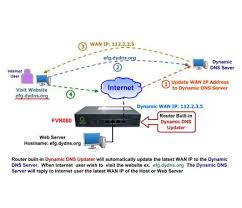 .
.
CCTV Camera Pros has documented specific dynamic DNS setup instructions for LinkSys and D-Link routers. The instructions are based on certain models, but are likely the same or close to the same for other models of D-Link and LinkSys routers. If you need specific instructions for you router, please consult the manual that came with your router and look under the section for DDNS or Dynamic DNS.

